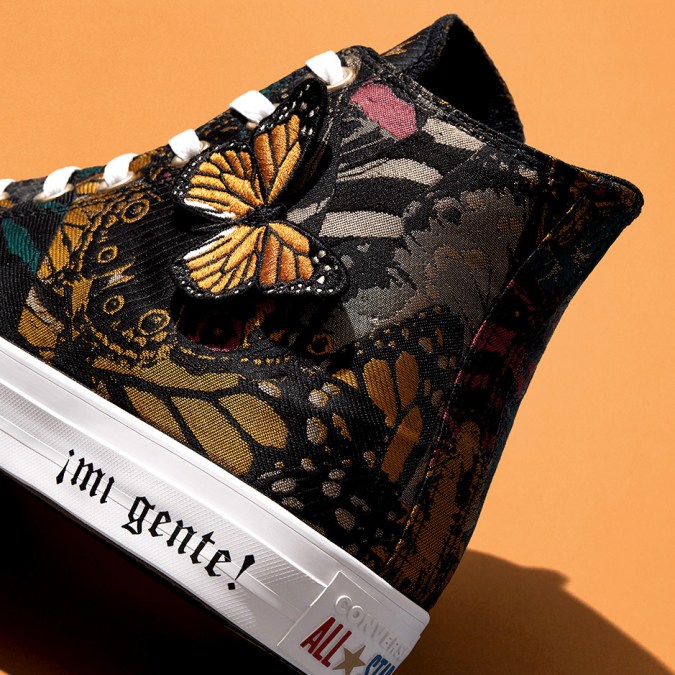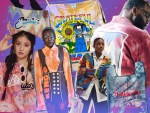“When I think of ‘mi gente’ I think of the hard-working, caring, welcoming, smart, cunning, hopeful people in my family,” illustrator Ruth Mora tells us. “’Mi gente’ starts at home and doesn’t end there—we extend our resources [and] love, to people outside our family and [that’s what] I feel describes our culture.”
Converse’s newly-released capsule, ¡Mi Gente!, is the brand’s most extensive Latin American heritage-honoring collection to date with a top and 6 distinct takes on the classic Chuck Taylor high-tops.
Beyond the ñ imprinted upon the All Star ankle patch, the Latines chosen to interpret the phrase make the sneaker a site to reclaim what the mainstream streetwear industry has consistently appropriated. The Chuck 70s covered in a black and cream color-contrast print of the phrase ‘¡mi gente!’ in the iconic Old English lettering that originated with Chicano artist Chaz Bojórquez, is a prime example of this. The “cholo font,” and the overall task of celebrating a few of our many layers as Latines, is undoubtedly more fitting in the hands of designers like the ones tapped for this project.
“I hope Converse and others see the good in our people this month and beyond.”
Say, Los Angeles-based Ruth Mora and Chicago-based Joseph Perez (Sentrock), for example. Mora, a lifelong illustrator, transplanted LA’s murals and Chicanx street culture onto Chuck Taylor’s canvas with a few obvious odes like the images of elotes, hot pink lowriders with “L.A. Livin’’ sketched on its sides or the femme figure with hoops. Others, not so much.

“Each element of the pattern I designed has personal and cultural meaning,” Mora says. “The flower element is an icon for me—gifted in life and death… symbolic of the life, love and romance in our culture.” Meanwhile, “the dog symbol is also such a familiar and ordinary subject when you walk around Latinx neighborhoods, and I feel they metaphorically describe us—loyal and protective. Lastly, the cockroach,” she says, getting real. “Although not the most glamorous element in my design, it is certainly the most ordinary—you’re bound to have a few roaches living rent-free in your household.”

Sentrock’s rusty red and deep blue illustrations, on the other hand, narrate the journey of an introspective young boy holding a banner that says “con sueños” while biking (major YHLQMDLG vibes) through an urban scene where he comes across icons from his community, like Nopal cactuses and snakes.
“It’s for the kids that have dreams, that are holding on to [their] heritage but still finding identity where [they’re] at,” Perez said in a statement.

Hinting at how Latinidad is not monolithic, the customizable kicks are particularly appealing because you can mix up to three prints.
Video producer and host Laurence “Overtime Larry” Marsach, for example, celebrated his Puerto Rican and Dominican heritage by combining the collection’s print with a tostone yellow. Meanwhile, skateboarder Vitoria Bortolo’s punchy red and pink Chucks channel Brazil’s Tropicalia art movement that resisted dictatorship through freedom of expression.
Three other high-tops are dedicated to Mexican, Dominican and Puerto Rican art. The Mexico sneaker evokes the cut paper folk art of papel picado with florals that toe the line between a loteria rose and a Frida Kahlo heart, the white ruffles on the crisp Puerto Rico sneaker mimic the movement of Bomba dancer’s skirts, and the butterfly print with appliques flying off of the Dominican Republic sneaker canvas act as a nod to “Las Mariposas.”


“I hope Converse and others see the good in our people this month and beyond,” Mora says. “But also reflect on how we can be better. Not just for our own, but for everyone out there who is marginalized. We are in this together.”
To bring the Mi Gente spirit to Latin America, Converse is commissioning murals from locals in Peru, Brazil, Mexico and Chile. Stateside, they will partner with LA-based, youth-empowering non-profit organizations (NGOS) such as Las Fotos Project, Homeboy Industries, and Boyle Heights Arts Conservatory, along with ZUMIX in Boston, where the brand was founded.
Let’s hope they keep amplifying the voices of the next generation year-round.





